featured roving canal trader
sam keay - gangplank spirits and preserves
My name is Sam Keay, I am originally from Cumbria. In my past I took my children to Africa where I worked as a volunteer teacher. We lived there with no running water or electric. When I returned home, I worked for Lancashire Wildlife Trust, Myerscough College and The Open University.
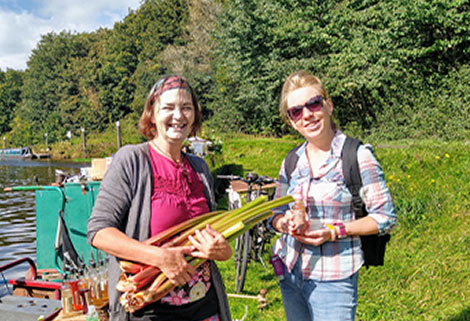 I now live and work on a travelling narrowboat business. I began as ‘Cake on the Cut’ making homemade cakes, hence my Salted Caramel Gin. But I have slowly evolved into ‘Gangplank Spirits & Preserves' and I make foraged fruit gin, whisky, rum, vodka, chutney, jam & cordial. I also open as a café selling soft drinks and crepes, and I have a fully licenced bar.
I now live and work on a travelling narrowboat business. I began as ‘Cake on the Cut’ making homemade cakes, hence my Salted Caramel Gin. But I have slowly evolved into ‘Gangplank Spirits & Preserves' and I make foraged fruit gin, whisky, rum, vodka, chutney, jam & cordial. I also open as a café selling soft drinks and crepes, and I have a fully licenced bar.
I was brought up growing a lot of our own produce; we had a big allotment, and bottled and froze the spoils. We had a Big Damson tree at the bottom of the garden, and it was my job to climb it. My Damson Gin recipe has been handed down through the generations and is still my favourite. I spent much of my childhood blackberrying and scrumping apples, so my business has really grown from my beginnings.
early boating
Growing up we had quite a few narrowboat holidays. I was only a few weeks old when we crossed the Pontcysyllte Aqueduct where I was apparently cosily tucked in my Moses basket in the bow.
We always hired boats out of season, when they were cheap, and I remember running ahead to do the locks, my hands sticking to the frost on the lock gates. Something must have appealed to me and stayed with me, because it seemed a very natural step to move onboard, although I did wait until my children had fled the nest, as I wisely decided I couldn’t live with two teenagers on a narrowboat!
living aboard
 I’ve been boating 15 years now and I’m still very in love with the lifestyle. The towpath is a friendly place where people like to talk to each other and help each other out. Most boaters are unmaterialistic and happy with the simple things in life, a fire, good company, a stew in the pot, and a pint.
I’ve been boating 15 years now and I’m still very in love with the lifestyle. The towpath is a friendly place where people like to talk to each other and help each other out. Most boaters are unmaterialistic and happy with the simple things in life, a fire, good company, a stew in the pot, and a pint.
I’ve had a lot adventures in the past 15 years that I wouldn’t trade for anything, I think I’ve seen all the 7 wonders of the canal system and so much more. Some of the highlights are:
Crossing the Ribble Link several times, never without a last minute crisis. The first time, I’d only had the boat 2 months and had to be towed by the coastguard as my alternator belt snapped halfway across.
The beautiful Kennet & Avon Canal, surrounded by stone circles, white horses and a history of crop circles. We enjoyed digging out the inflatable canoe and taking picnics paddling down the Avon and mooring right in the centre of bustling Bristol.

Toiling over the stunning Pennines, with empty pounds, badly maintained heavy double locks, dog tired and muddy, but exhilarated and very alive.
Last year I fulfilled another small dream and cruised her up the Tidal Thames from Limehouse to Oxford where my little hippie boat sailed alongside the gin palaces and big working barges. I cruised past the Houses of Parliament and the London eye feeling ridiculously small and excited.
every day is different
 The everyday small adventures are just as fun, all the windy rainy days, being blown across the cut, fallen trees blocking the canal, single handing swing bridges that open on the wrong side, going down the weed hatch for the third time in a day...
The everyday small adventures are just as fun, all the windy rainy days, being blown across the cut, fallen trees blocking the canal, single handing swing bridges that open on the wrong side, going down the weed hatch for the third time in a day...
I enjoy seeing the country through the perspective of the waterways, a city looks very different by water, and I love that one day I can be moored in a city centre and the next moored in an isolated country haven. I feel very privileged to watch a heron hunt from my window and a kingfisher flit by.
There are a few downsides, I hate trying to organise deliveries for my business, dealing with black and white thinking bureaucrats who can’t understand that you don’t have an address, and the never ending fixing things can be a challenge but more than worth it.
good and bad days
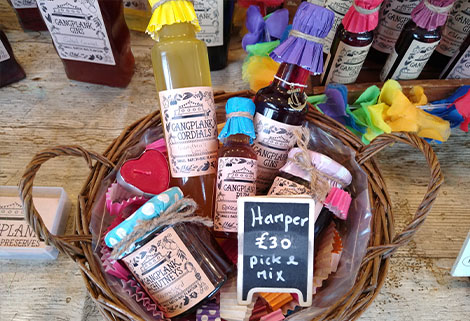 This year has been one of the most difficult I’ve ever had on the cut. I had to have a complete re-plate of my boat during lockdown and borrow the money in one of the most financially challenging years for my business.
This year has been one of the most difficult I’ve ever had on the cut. I had to have a complete re-plate of my boat during lockdown and borrow the money in one of the most financially challenging years for my business.
I managed to break my ankle just as the job was completed and an exceptionally good friend, a fellow trader, lost her battle with cancer and we had to give her a ‘virtual’ send off.
I’ve also had a few previously unheard-of negative conflicts with trading on the towpath, mostly from other very anxious struggling businesses that have seen me as a threat to their livelihood.
keeping going
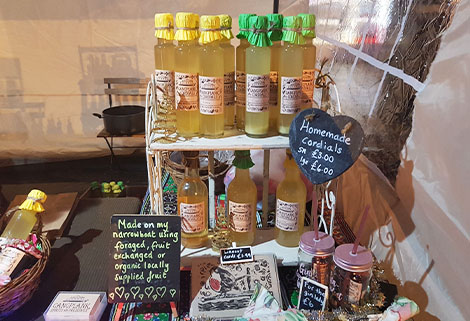 Fortunately this has been more than compensated for by the number of super generous people who have gone out of their way to support me and my small business, and realising more than ever what fantastic friends and family I’m lucky enough to have.
Fortunately this has been more than compensated for by the number of super generous people who have gone out of their way to support me and my small business, and realising more than ever what fantastic friends and family I’m lucky enough to have.
All of my festivals, events and floating markets were cancelled this year which is my normal bread and butter to see me through the winter, so I have had to trade on the towpath wherever and whenever it’s been possible.
 The public have been incredible, people have really been trying to support the small business owner for which I am immensely thankful. They have literally kept me afloat.
The public have been incredible, people have really been trying to support the small business owner for which I am immensely thankful. They have literally kept me afloat.
new website
My son made me a website at the end of last year and it was an unforeseen huge help to my business this year. It has really taken off for obvious reasons and I also have some interest in supplying my produce to gin bars and artisan shops.
If you fancy some truly homespun ‘It’s A Wonderful Life’ Christmas Spirit please look at my products on www.gangplank.shop

 Back in February I won the ‘Best Comedy’ award for my short stage play at The Worcestershire Theatre Festival.
Back in February I won the ‘Best Comedy’ award for my short stage play at The Worcestershire Theatre Festival. I was walking the dogs, Blue and Milly, down the towpath toward bridge number 38. It was coming to that weird sort of half-light between afternoon and dusk and we were happily trotting along - well the dogs were, I was shuffling about as usual - when a ghostly spectre appeared out of the mist (it wasn’t actually misty, but I’m trying to create an atmosphere, o.k?) A vision of Darth Vader appeared from under the arch and began to charge toward us at an alarming rate of knots. He was easily seven feet tall, dressed entirely in black, topped with a helmet with tinted visor. And - get this - he glided. Yes, that’s right, he glided - moving neither arms nor legs.
I was walking the dogs, Blue and Milly, down the towpath toward bridge number 38. It was coming to that weird sort of half-light between afternoon and dusk and we were happily trotting along - well the dogs were, I was shuffling about as usual - when a ghostly spectre appeared out of the mist (it wasn’t actually misty, but I’m trying to create an atmosphere, o.k?) A vision of Darth Vader appeared from under the arch and began to charge toward us at an alarming rate of knots. He was easily seven feet tall, dressed entirely in black, topped with a helmet with tinted visor. And - get this - he glided. Yes, that’s right, he glided - moving neither arms nor legs. As he drew level briefly, by now he was moving at just below subsonic speed, I saw that it was only some chap, in full motorcycle regalia, stood on - honestly, I kid you not - stood on a single motorised wheel about 2 feet (I’m not sure what that works out to in tonnes per hectare, or whatever it is these days) in diameter. Two footrests extended out from either side of the axle on which he balanced like a trick cyclist at the circus. I assume that he controlled the speed by leaning forward or back as they do on one of those Segway thingy’s you can hire out on your holibobs in Benidorm, but it was hard to tell as we were buffeted around in his wake amid a swirl of fallen autumn leaves, towpath dust and small dead mammals, slaughtered on his passage through the countryside.
As he drew level briefly, by now he was moving at just below subsonic speed, I saw that it was only some chap, in full motorcycle regalia, stood on - honestly, I kid you not - stood on a single motorised wheel about 2 feet (I’m not sure what that works out to in tonnes per hectare, or whatever it is these days) in diameter. Two footrests extended out from either side of the axle on which he balanced like a trick cyclist at the circus. I assume that he controlled the speed by leaning forward or back as they do on one of those Segway thingy’s you can hire out on your holibobs in Benidorm, but it was hard to tell as we were buffeted around in his wake amid a swirl of fallen autumn leaves, towpath dust and small dead mammals, slaughtered on his passage through the countryside.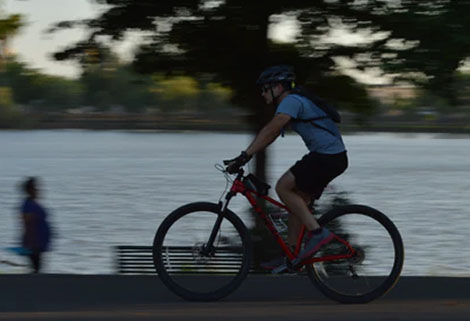
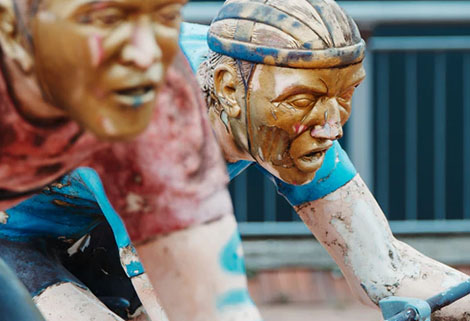 But the real culprit I’m afraid is Andy Street, Mayor of the West Midlands. He’s a champion of old style technology like trams, trains and of course bikes. I’m sure he’d like us all to become latter day Edwardians and am expecting him to launch an initiative soon to eschew our en-suite bathrooms in favour of building outdoor privy’s and wiping our bums on torn up squares from The Sun.
But the real culprit I’m afraid is Andy Street, Mayor of the West Midlands. He’s a champion of old style technology like trams, trains and of course bikes. I’m sure he’d like us all to become latter day Edwardians and am expecting him to launch an initiative soon to eschew our en-suite bathrooms in favour of building outdoor privy’s and wiping our bums on torn up squares from The Sun.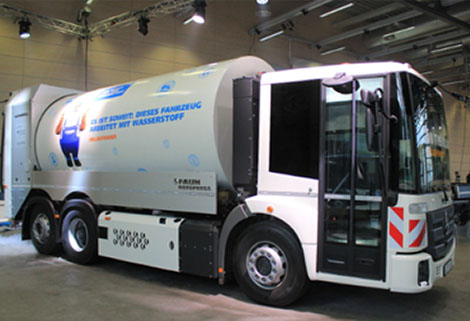
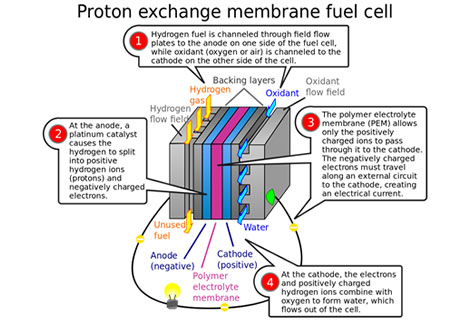 Now that industries such as transport and heating are struggling to maintain the levels needed using conventional batteries, hydrogen has come back into the frame. A typical example of this is the company JCB who have produced a new prototype mechanical digger which would need a battery weighing five tonnes and take hours to refuel.
Now that industries such as transport and heating are struggling to maintain the levels needed using conventional batteries, hydrogen has come back into the frame. A typical example of this is the company JCB who have produced a new prototype mechanical digger which would need a battery weighing five tonnes and take hours to refuel. Having first done my tap and trace with a QR code laminated and stuck on Dawn Treader's door, I am writing this down below on a very stormy, blowy Halloween.
Having first done my tap and trace with a QR code laminated and stuck on Dawn Treader's door, I am writing this down below on a very stormy, blowy Halloween.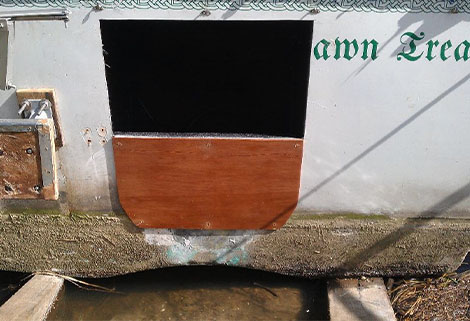 We are all exposed to a small amount of it when we run our engines, but generally the wind etc. takes most of it away. But the CO detector has already received a certain amount. However, at this very point in the canal I slow up for the bridge, which is on an acute angle so you can't see under it. The canal is in quite a deep cutting with high hedges both sides and steep banks with the wind directly behind me, so momentarily the exhaust gas catches up with me and briefly exceeds the level.
We are all exposed to a small amount of it when we run our engines, but generally the wind etc. takes most of it away. But the CO detector has already received a certain amount. However, at this very point in the canal I slow up for the bridge, which is on an acute angle so you can't see under it. The canal is in quite a deep cutting with high hedges both sides and steep banks with the wind directly behind me, so momentarily the exhaust gas catches up with me and briefly exceeds the level.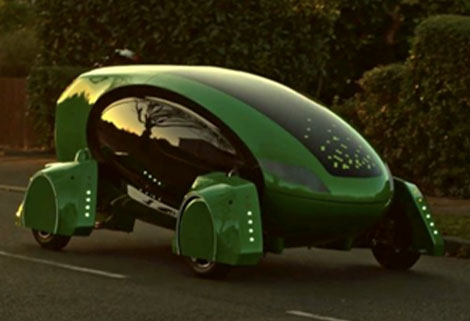
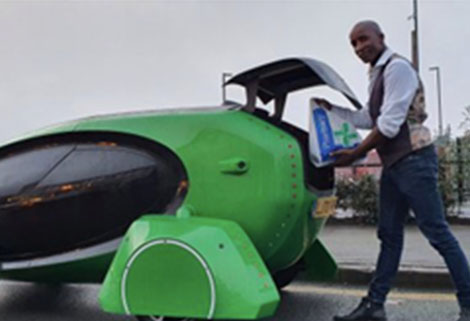
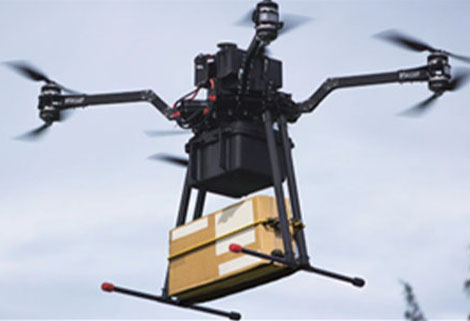
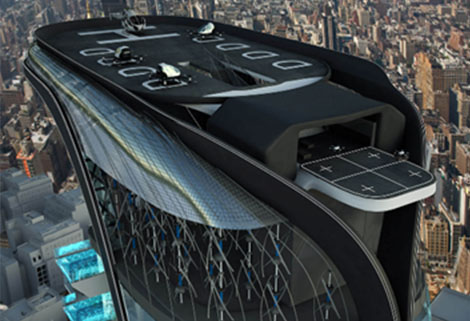

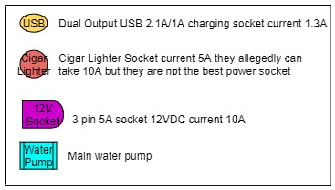 First the symbols chart and an explanation of each item the USB outlets, Cigar Lighter etc are I expect apparent what is not is the Wago. They are a modern version of the old chocolate block and a lot better. When wiring things like the USBs etc they can either be wired with one cable all the way back to their own individual fuse or the supply cable can be broken where each USB etc is to go and the supply cable broken and joined to run on to the next one.
First the symbols chart and an explanation of each item the USB outlets, Cigar Lighter etc are I expect apparent what is not is the Wago. They are a modern version of the old chocolate block and a lot better. When wiring things like the USBs etc they can either be wired with one cable all the way back to their own individual fuse or the supply cable can be broken where each USB etc is to go and the supply cable broken and joined to run on to the next one.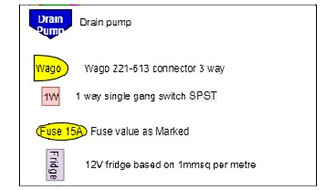 The Wago is the modern equivalent of the chocolate block connector but a 100 times better and unlike the Chocolate Block it does not damage the strands of the cables. It is also easier to fit, prepare the wire, lift the orange clip, slide the wire in, and push the orange clip back down job done. They cannot come open pushing the clip down locks them.
The Wago is the modern equivalent of the chocolate block connector but a 100 times better and unlike the Chocolate Block it does not damage the strands of the cables. It is also easier to fit, prepare the wire, lift the orange clip, slide the wire in, and push the orange clip back down job done. They cannot come open pushing the clip down locks them.


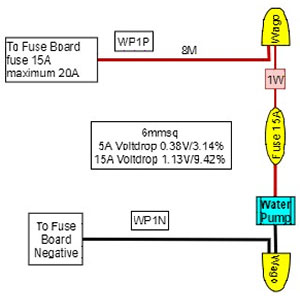



 Long ago I met my future wife after mooring up next to her. We spent the next few years being young ‘love-aboards’ and enjoying Narrowboat life.
Long ago I met my future wife after mooring up next to her. We spent the next few years being young ‘love-aboards’ and enjoying Narrowboat life. It suddenly dawned on me that if it had a basket of some sorts I could just bung it all in and it would take the faff and balancing act out of the procedure.
It suddenly dawned on me that if it had a basket of some sorts I could just bung it all in and it would take the faff and balancing act out of the procedure. Surely, I asked myself, there must be something available already? No - nothing. Nothing at all like it was available as a stove accessory for coal.
Surely, I asked myself, there must be something available already? No - nothing. Nothing at all like it was available as a stove accessory for coal. All the while this process was going on it was the hardest thing to keep quiet! We we’re so excited with how it was working and improving our stove experience. Visitors to the boat were kept at a minimum whilst we tried surreptitiously to draw any attention away from our stove. We now couldn’t imagine life without it!
All the while this process was going on it was the hardest thing to keep quiet! We we’re so excited with how it was working and improving our stove experience. Visitors to the boat were kept at a minimum whilst we tried surreptitiously to draw any attention away from our stove. We now couldn’t imagine life without it!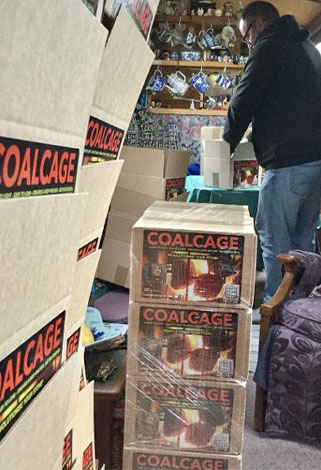 Getting the first batch was so exciting as it suddenly became real. Boxes and labels agreed with a local printer and we were away.
Getting the first batch was so exciting as it suddenly became real. Boxes and labels agreed with a local printer and we were away. Rosie & Wayne Sharman live aboard their narrowboat James Arthur and if you are lucky enough to spot them on the cut, you can buy directly from their boat.
Rosie & Wayne Sharman live aboard their narrowboat James Arthur and if you are lucky enough to spot them on the cut, you can buy directly from their boat. The Oxbow Excel briquettes are produced at our plant in County Durham in the North East of England.
The Oxbow Excel briquettes are produced at our plant in County Durham in the North East of England.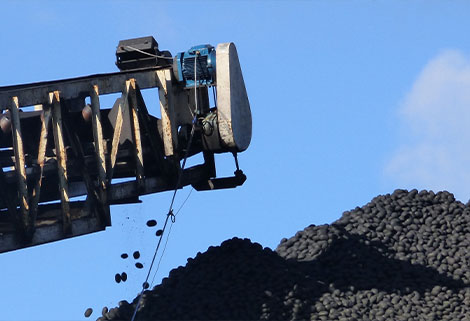 Since then Oxbow have learned not to mess with the classics and the Oxbow Excel remains consistently top quality with the recipe largely unchanged for many years.
Since then Oxbow have learned not to mess with the classics and the Oxbow Excel remains consistently top quality with the recipe largely unchanged for many years. Instead of bringing out a new fuel to compliment the open fire fuel Oxbow Excel was considered to be, Oxbow, with minor adjustments, made the fuel versatile enough in its own right to be considered a multi-purpose fuel.
Instead of bringing out a new fuel to compliment the open fire fuel Oxbow Excel was considered to be, Oxbow, with minor adjustments, made the fuel versatile enough in its own right to be considered a multi-purpose fuel. Oxbow Coal Ltd provides a diverse line of products, backed by expert technical support and knowledgeable customer service. Our philosophy is that the most effective way to earn a customer’s trust and loyalty is through the superior performance of our products as well as the energy and talent of our people.
Oxbow Coal Ltd provides a diverse line of products, backed by expert technical support and knowledgeable customer service. Our philosophy is that the most effective way to earn a customer’s trust and loyalty is through the superior performance of our products as well as the energy and talent of our people.